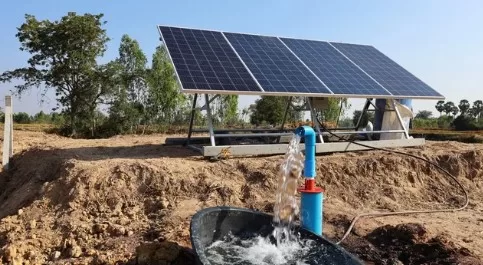Are you looking for an eco-friendly and cost-effective solution to your water pumping needs, including solar-powered water fountain pumps? Solar-powered water pumps might be the answer! These innovative devices harness the power of the sun to pump water for various applications, from irrigation to residential water supply. We’ll discuss the advantages, components, types, and applications of solar-powered water pumps, as well as how to select, install, and maintain them.

Advantages of Solar-Powered Water Pumps
Energy Savings
Solar-powered water pumps use free and abundant sunlight to operate, reducing or even eliminating the need for electricity or fossil fuels. This results in significant energy savings, making them an attractive option for those looking to reduce their energy bills and dependence on non-renewable energy sources.
Environmental Benefits
By using solar energy, solar-powered water pumps reduce greenhouse gas emissions and decrease the overall carbon footprint. They are an environmentally responsible choice for those who want to minimize their impact on the planet.
Versatility and Flexibility
You can use solar-powered water pumps in a variety of applications and settings, ranging from remote off-grid locations to urban areas. Easily expand or scale down these systems according to your specific needs and energy requirements.
Low Maintenance
Compared to traditional water pumps, solar-powered pumps require minimal maintenance, mainly because they have fewer moving parts. This translates to lower operating costs and less downtime.
Components of a Solar-Powered Water Pumping System
Solar Panels
Solar panels, also known as photovoltaic (PV) modules, are the heart of a solar-powered water fountain pumping system. They convert sunlight into electricity, which powers the pump.
Controller
The controller regulates the voltage and current from the solar panels to the pump, ensuring optimal performance and protecting the system from damage.
Pump
Solar-powered water pumps come in various types and sizes, suitable for different applications. The two main categories are submersible and surface pumps.
Water Storage
A storage tank or reservoir is often used in solar-powered water pumping systems to store water when sunlight is available, ensuring a consistent water supply when needed.
Types of Solar-Powered Water Pumps
Submersible Pumps
Submersible pumps are submerged underwater, typically in a well, borehole, or pond. They are ideal for deep water sources and are more efficient because they push water up rather than pulling it.
Surface Pumps
Install surface pumps above ground, making them suitable for shallow water sources like rivers or lakes. These pumps draw water up and serve various applications, including irrigation, livestock watering, and residential water supply.
Solar Pump Sizing and Selection
Choosing the right solar-powered water pump depends on factors like water source depth, daily water requirements, and location. Consulting with a professional or using online tools can help you determine the appropriate pump size and solar panel capacity for your specific needs.
Installation and Maintenance
Solar-powered water pump systems should be installed by experienced professionals to ensure optimal performance and safety. Regular maintenance, including cleaning the solar panels and checking for any damage, is essential to keep the system running efficiently. Additionally, periodic inspections by professionals are recommended to identify and address any potential issues.
Costs and ROI
While the initial cost of a solar-powered water pump system might be higher than a traditional one, the long-term savings in energy costs and reduced maintenance make them a wise investment. Depending on the size of the system and local energy prices, the return on investment (ROI) can be realized in just a few years.
Applications of Solar-Powered Water Pumps
Irrigation
Solar-powered water pumps are perfect for agricultural irrigation, providing a consistent and eco-friendly water supply for crops.
Livestock Watering
In remote or off-grid locations, solar-powered water pumps can efficiently supply water to livestock, reducing the need for manual labor and ensuring a reliable water source.
Residential Water Supply
For homes in rural or off-grid areas, solar-powered water pumps offer a dependable and cost-effective solution for meeting daily water needs.
Remote Water Supply
Solar-powered water pumps supply water to remote communities, campsites, and emergency relief operations where limited access to electricity or traditional water sources exists.
Conclusion
Solar-powered water pumps offer numerous advantages, including energy savings, environmental benefits, versatility, and low maintenance. By understanding the different components, types, and applications, you can select the ideal solar-powered water pump system for your needs. With proper installation and maintenance, these systems can provide a reliable and sustainable water supply for years to come.
FAQs
How do solar-powered water pumps work?
Solar-powered water pumps use solar panels to convert sunlight into electricity, which powers the pump and moves water from the source to the desired location.
Can solar-powered water pumps work at night?
Solar-powered water pumps typically operate during daylight hours when sunlight is available. However, by adding a battery storage system, the pump can continue to operate during nighttime or cloudy days.
Are solar-powered water pumps suitable for all climates?
Solar-powered water pumps can work in various climates, provided there is sufficient sunlight. In areas with limited sunlight, it may be necessary to increase the solar panel capacity or use a hybrid system that combines solar power with another energy source.
How long do solar-powered water pumps last?
Solar-powered water pumps can last up to 20 years or more with proper installation, maintenance, and care. Solar panels usually have a 25-year performance warranty.
Can you use solar-powered water pumps for high-capacity applications?
Absolutely! You can design and scale solar-powered water pumps to handle high-capacity applications like large-scale irrigation or providing water supply for entire communities.